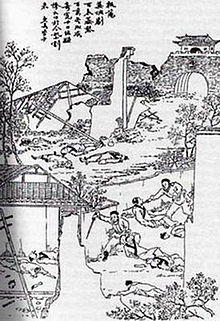- Yangzhou massacre
-
Yangzhou massacre Traditional Chinese 揚州十日 Simplified Chinese 扬州十日 Literal meaning Ten Days of Yangzhou Transcriptions Mandarin - Hanyu Pinyin Yángzhōu Shí Rì The Yangzhou massacre took place in 1645 in Yangzhou, China, during the Qing Dynasty. Mass killings of residents in Yangzhou were conducted by Qing troops under the command of Prince Dodo after they conquered the city from forces loyal to the Southern Ming regime of the Hongguang Emperor.
The massacre lasted ten days after the city fell on May 20, 1645. Traditionally, the number of victims was reported as close to 800,000, although some modern scholars consider it an exaggeration.[1] The defending commander, Shi Kefa, was also executed by Qing forces after he refused to submit to their authority.
The alleged reasons for the massacre were:
- To punish the residents because of resistance efforts led by the Ming official Shi Kefa.
- To warn the rest of the population in Jiangnan of the consequences of resisting the invaders.
The book An Account of Ten days at Yangzhou by Wang Xiuchu, (English translation and annotation by Lynn A. Struve[2]) was a first-person eyewitness account of the massacre. Following are excerpts from Wang Xiuchu's report (in Struve's translation):
“ Several dozen people were herded like sheep or goats. Any who lagged were flogged or killed outright. The women were bound together at the necks with a heavy rope - strung one to another like pearls. Stumbling with each step, they were covered with mud. Babies lay everywhere on the ground. The organs of those trampled like turf under horses' hooves or people's feet were smeared in the dirt, and the crying of those still alive filled the whole outdoors. Every gutter or pond we passed was stacked with corpses, pillowing each others arms and legs. Their blood had flowed into the water, and the combination of green and red was producing a spectrum of colors. The canals, too, had been filled to level with dead bodies. ” “ Then fires started everywhere, and the thatched houses...caught fire and were soon engulfed in flames...Those who had hidden themselves beneath the houses were forced to rush out from the heat of the fire, and as soon as they came out, in nine cases out of ten, they were put to death on the spot. On the other hand, those who had stayed in the houses - were burned to death within the closely shuttered doors and no one could tell how many had died from the pile of charred bones that remained afterwards. ” There were many other massacres.[3][4] Books written about the massacres in Yangzhou, Jiading and Jiangyin were republished by the revolutionists to win support.[5][6]
See also
- Anti-Qing sentiment
Reference
- ^ Struve (1993) (note at p. 269), following a 1964 article by Zhang Defang, notes that the entire city's population at the time was not likely to be more than 300,000, and that of the entire Yangzhou Prefecture, 800,000.
- ^ Struve (1993, pages 28-48
- ^ 滿清屠殺暴行資料匯總之一
- ^ 与阎崇年先生论辩:. 怎样看待满清皇朝康乾盛世
- ^ 朱子素, 嘉定屠城紀略
- ^ 韓菼, 江陰城守紀
Literature
- Voices from the Ming-Qing Cataclysm: China in Tigers' Jaws, Struve, Lynn A. Publisher:Yale University Press, 1998, ISBN 0300075537, 9780300075533. 312 pages
Categories:- Qing Dynasty
- History of Jiangsu
- Conflicts in 1645
- Massacres in China
Wikimedia Foundation. 2010.

